|

Class of 2004 Commences on the Ellipse | New Program Addresses Student Writing Skills | The Ultimate Challenge | Lighting up the Basketball Season | Arabic Studies Summer Program | Faculty Focus | Election 2004 | The Students' Ivory Tower | GW Honors Top Donors | High-Tech Hideaway | The J Street Scene | Reagan's GW Legacy | GW Welcomes Five New Trustees | The Mysteries of Megiddo | At a Glance | GW in History

Class of 2004 Commences on the Ellipse
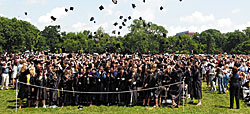
Photo by Claire Duggan
|
The cicadas thankfully kept away as more than 20,000 GW graduates, family members, and friends celebrated GW’s 180th Commencement May 16. The majestic Ellipse once again provided a perfect backdrop for the festive gathering, featuring the conferring of degrees on 5,500 members of the Class of 2004.
Four prominent guest speakers addressed the enthusiastic crowd: noted oncologist and arts benefactor Luther W. Brady, BA ’46, MD ’48; Nobel Prize-winning physicist Leon Lederman; Folger Shakespeare Library Director Gail Paster; and former chairman of the Joint Chiefs of Staff Gen. John M. Shalikashvili, MS ’70. GW President Stephen Joel Trachtenberg presented honorary degrees to the distinguished foursome, noting that “each have made a difference in our world—in their own ways and in four different fields. They have made our lives safer, richer, longer, and unquestionably better.”
As always, a special highlight of commencement was the awarding of honors to outstanding graduates, and faculty and staff members. GW’s Distinguished Alumni Achievement Award went to four alumni who have made a lasting impact on society: James C. Cacheris, LLB ’60, former chief judge of the U.S. District Court for the Eastern District of Virginia; Nancy B. Jackson, BS ’79, technical manager of chemical and biological sensing for the imaging department of Sandia National Laboratories; Allyn E. Kilsheimer, BS ’63, who was chosen by the Department of Defense in September 2001 to lead the reconstruction and restoration of the Pentagon; and Jung-Sook Kim, EdD ’88, who is currently serving her third term as a member of the National Assembly of the Republic of Korea.
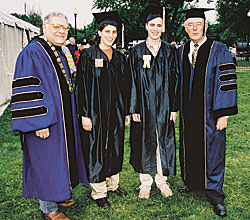
President Trachtenberg (far left) and Chairman of the Board of Trustees Charles T. Manatt (far right) with the co-winners of the inaugural Manatt-Trachtenberg Prize, Allison Robbins (second from left) and Graham Murphy.
Photo by Thom Kohout
|
Co-winners of the inaugural Manatt-Trachtenberg Prize recognizing undergraduate leadership were community activists Graham Murphy and Allison Robbins. Created by The Hon. Charles T. Manatt, JD ’62, chairman of GW’s Board of Trustees, and President Trachtenberg, the annual award honors graduating seniors who raise the social consciousness and intellectual vitality of the GW community.
Three outstanding GW professors received 2004 Oscar and Shoshana Trachtenberg Prizes for excellence, endowed by President Trachtenberg in memory of his parents. Shoko Hamona, associate professor of Japanese, was recognized for excellence in teaching; Peter Reddaway, professor of political science and international affairs, for excellence in faculty scholarship; and Philip Wirtz, professor of psychology and management science, for exceptional service to the University.
Continuing a well-loved tradition established in 1976, three members of the GW community received the GW Award for their lasting contributions to the University. This year’s honorees included James Ferrer, director of GW’s Center for Latin American Issues; Mark Levine, senior assistant dean of the Community Living and Learning Center; and law student and dean’s fellow Ann O’Connell.
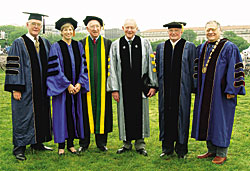
(From left) Board of Trustees Chair Charles Manatt; Honorary Degree Recipients Gail Kern Paster, Luther W. Brady, Leon M. Lederman, and John M Shalikashvili; and University President Stephen Joel Trachtenberg gather at the Ellipse on May 16.
Photo by Claire Duggan
|
In his charge to the newly minted graduates, Trachtenberg spoke about the impact of recent terrorist attacks, including the March 11 train bombings in Madrid, on the world and on GW. “When I heard about the train bombings, my blood ran cold,” he said. “My first thought, my first reaction, was GW has 36 students in a program in Madrid. Are they all right?”
Fortunately, they were all fine, but Trachtenberg says that he took some important lessons with him from the experience. “The sense of community we like to talk about at GW is real,” he says. “There is something very deep that binds us. We all have a share in a common enterprise…I am hopeful that you all profited from our sense of community in your time here—that your learning and your degree will not be the only durable things that you take away from GW.”
—Jamie L. Freedman

New Program Addresses Student Writing Skills
In the fall of 2003 as part of its Strategic Plan for Excellence, the University unveiled a writing program designed to present consistent writing requirements to all undergraduates and foster fundamental communications skills. In the program’s trial phase, 700 freshmen—about one-third of the class of 2007—were randomly selected from the Columbian Colleges of Arts and Sciences and the Elliott School of International Affairs to take the first stage of the program. The overall program consists of the Freshman Writing Program, or UW20; the Writing in Disciplines Program; and two sophomore- and junior-level writing intensive courses, which are offered by individual departments throughout the University.
Now, after its successful initial run and a summer of gathering student and instructor feedback and holding faculty workshops, the program is moving forward under the leadership of CCAS Dean William Frawley and Executive Director Melinda Knight, who was involved with writing programs at the University of San Francisco and New York University. This semester, about 1,600 freshmen from all the schools will take one of the four-credit courses. By 2005, all incoming undergraduate students will be enrolled.
Frawley says preparing students for the professional world by helping them gain a deeper understanding of the discipline is imperative to their overall education.
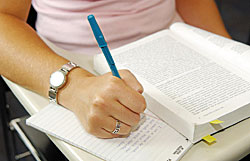
Photo by Claire Duggan
|
“One of the essential competencies for full and effective participation in the new ‘knowledge society’ is the ability to write accurately and carefully, with attention to detail, planning, and revision, sensitivity to the traditions of sophisticated expression, and critical awareness and imagination”, Frawley says. “This is a daunting task. We have constructed a program at GW that addresses all these things and hence is at the forefront of writing instruction in the United States.”
Taking the program from the planning stages to reality has been a complicated process, but Frawley says the University as a whole has taken it in stride.
“There are the usual challenges—resources, planning, assessment, space, etc. But these pale against the real challenge, which is to change the belief system of students, faculty, and staff to one that takes sophisticated and careful written expression as fundamental and pervasive in the GW experience and an essential responsibility at GW,” Frawley says. “I am happy to say that, as far as I can see, everyone has risen admirably to this challenge, and this enormously positive response is perhaps the greatest reward of this undertaking.”
While the program has gotten off to a good start, Frawley says faculty and student feedback is being gathered and reviewed to help the program grow.
“The class has been very well received, as both the empirical assessments and informal comments show. It is a hard course, and student and faculty response to this challenge has been especially favorable. As in all good programs, the University Writing Program learns continually from its successes and any missteps we might make along the way,” Frawley says. “We conduct not only summative assessments—which evaluate how well the program is working compared to other efforts—and also formative assessments—which show how we can use feedback to modify and advance the curriculum. The program also conducts many workshops and regular pedagogical discussions as faculty reflect on their practice and trade ideas. We have learned a great deal about effective syllabi, assignments, new techniques such as peer editing, and the like throughout this first year. As yet, we do not know the results of our first efforts at the Writing in Disciplines Program, since these courses are running right now. But I expect similar positive results all around.”
Frawley says the success of the program thus far is due in large part to strong leadership.
“The GW Writing Program is in terrifically capable hands with Melinda Knight. Our goal is to produce the best writing program in the country,” Frawley says. “We expect to say, with no hesitation, that when you graduate from GW, you will be able to write well and that others will recognize this capability in you—that writing competency is an essential characteristic of a GW education.”
—Laura Ewald

The Ultimate Challenge
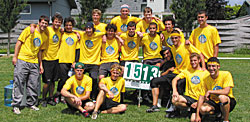
Members of GW’s Ultimate Frisbee men’s team pose after a victory.
|
In 1997, Dave Watermulder, BA ’00, and Thomas Shields, BA ’02, brought the “Ultimate” bug to GW. Both played Ultimate Frisbee in high school, and with Watermulder’s sister, Sarah Watermulder, BA ’01, they met with a handful of students on the fields on 23rd Street and Constitution Avenue to teach the basics of the game.
“We faced a number of challenges in setting up the club, from registering as a club sport to getting people on the team to getting an adviser,” Watermulder says of the sport’s humble beginnings at the University. “But we were proselytizers of the sport and set up games with teams like American University. I think the current team can’t quite imagine what it was like to walk onto a field with only two or three people who could throw a disc, who knew the rules, or had played before.”
These days, the men’s Ultimate Frisbee Club, a rapidly growing recreational sports team on campus, attracts about 50 players per season. Like the also popular GW women’s Ultimate Frisbee team, they play under the Ultimate Players Association, a participant-run, not-for-profit organization that serves as the governing body of the sport in the United States. It boasts 15,600 members and hundreds of volunteers nationwide. The men’s team travels the country to play games, honing their skills and having a good time with friends. They are the “Hungry Hungry Hippos.”
“Ultimate teams don’t usually bear their college names; they use this opportunity to express their creativity and separate themselves from the NCAA sports,” says Ben Faust, co-captain. “Our team name mixes some of GW’s history with some fun originality.”
But in such a competitive, intense sport that attracts highly dedicated players, sometimes the name doesn’t live up to the team, Faust says.
“As the sport continues to evolve and becomes more competitive, the ‘Hungry Hungry’ part of our name is being left behind. When you’re playing teams like Stanford’s ‘Bloodthirsty’ and UNC-Chapel Hill’s ‘Dark Side,’ you’re a little self-conscious sharing a name with a board game.”
While he is unclear about the origins of the sport itself (“I think it involved pie tins, a parking lot, and some high school kids in New Jersey”), Faust says he understands why Ultimate players are willing to put in long practices and travel great distances for the love of the game.
“Ultimate is interesting in that players sacrifice so much to play a sport in which the only thing you have to show after a grueling season—besides the everyday bruises and lacerations—is respect shown to you inside the Ultimate community,” he says. “In any club sport, you play because you have fun doing it. For our team, more and more students are coming out because they are blown away by the athleticism and intensity that is taking over the college game.”
In the spring semester, the team played 53 competitive games, all to get closer to the season’s goal of making it to the nationals.
“There were 16 weekends this spring and we were in the District for eight of them. The rest was spent traveling and playing in games,” Faust says. “You gear up the whole spring for the tournaments.”
The highlight of the season was during Memorial Day weekend, when 18 Hippos competed in the 2004 Ultimate Players Association National Championships in Seattle. They won the team’s first victory at nationals with a 15-13 defeat of Illinois, and moved up in the rankings to be the 11th overall seed.
Faust says the team is attracting new members.
“We’re excited, and we’re finding that many freshmen are now coming to college with intentions of playing Ultimate competitively,” Faust says. “The more incoming students with such a desire means we don’t have to take the time convincing people to play but can instead start out strong with intensity, right from the first practice.”
Lighting up the Basketball Season
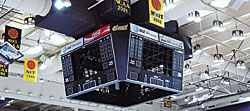 When fans fill the Smith Center this basketball season, they will be treated to a new center scoreboard featuring high-quality video and graphical capabilities and instant replay options. Though a bit smaller than the old scoreboard, the new board boasts a 10mm LED display, “the next generation of video scoreboards,” according to Assistant Athletic Director for Facilities Tony Vecchione. The men’s team begins play Nov. 10, when it hosts Randolph-Macon in a preseason exhibition game at 8 p.m. The women’s team opens its season the same day with a preseason exhibition game against UMMC-Ekaterinburg at 6 p.m. When fans fill the Smith Center this basketball season, they will be treated to a new center scoreboard featuring high-quality video and graphical capabilities and instant replay options. Though a bit smaller than the old scoreboard, the new board boasts a 10mm LED display, “the next generation of video scoreboards,” according to Assistant Athletic Director for Facilities Tony Vecchione. The men’s team begins play Nov. 10, when it hosts Randolph-Macon in a preseason exhibition game at 8 p.m. The women’s team opens its season the same day with a preseason exhibition game against UMMC-Ekaterinburg at 6 p.m.
Cheering on the teams will be another new addition to the Smith Center: the Colonial Army. The most elite student group of GW basketball fans, the Colonial Army has access to behind-the-bench seating during home games, participates in tailgate parties, wears T-shirts and bracelets to show their support, and enjoys discounted tickets on road trips.
Photo by Claire Duggan
|
Arabic Studies Summer Program
In response to the increasing need for fluent Arabic speakers in public and private circles, the GW Classics Department and the University Honors Program conducted a summer Arabic studies program for honors students. The Margaret and Edward Gnehm Summer Honors Program in Arabic Language Studies provided a full-tuition summer grant for a 12-week, eight-credit course giving students the opportunity to learn the fundamentals of the language. The 31 students, who were selected from a pool of 57 candidates, now continue their Arabic studies in the fall term. Students who competed for the program wrote an essay explaining why they feel the study of Arabic is significant.
“It says a lot about the academic commitment of these students that they were willing to stay in Washington and attend classes during the summer break,” says David Rowley, deputy director of the honors program.
The program is a direct response to the United States’ need for Arabic-speaking citizens in the aftermath of Sept. 11. Although college enrollment in Arabic nearly doubled between 1998 and 2002, study of the language in the United States is still relatively modest.
“With this program, the University steps up to serve our country and the international community in a positive way,” says GW President Stephen Joel Trachtenberg. “Educating our students to facilitate communication with the Arab world is one way that GW can be part of the solution to the global challenges of our times.”
The program was formed through the inspiration and support of Ambassador Edward Gnehm and his wife, Margaret Gnehm. He is a former member of the GW Board of Trustees and a U.S. Ambassador to Jordan, Kuwait, and Australia who raised the American flag over the U.S. embassy after the liberation of Kuwait in 1991. He was named this year’s J.B. and Maurice C. Shapiro Professor in the Elliott School of International Affairs.
A second program is planned for the summer of 2005.

Faculty Focus
A Series of Personal Glimpses of GW Faculty Members
‘New History’ for the Next Generation
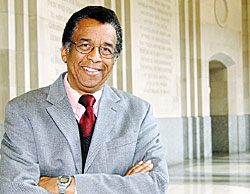
Professor James Horton
Photo by Claire Duggan
|
You don’t have to be a GW student to have James Horton as a teacher. He brings history to you. As the Benjamin Banneker Professor of American Studies and History and the president of the Organization of American Historians, the world’s largest professional association dedicated to American history, he’s finding new ways to educate in a new world.
“Today, people don’t necessarily learn history in classrooms. They learn it in novels, on television, on the Internet, from movies, from museums, from historic sites,” Horton says. “We have to change the way we present history to keep up with the way people are learning it.”
This varied list of mediums is why Horton’s name and face are attached to such varied projects: He provided commentary for the DVD version of the film “Glory”; has an upcoming mini-series and companion book (co-written with his wife, Lois), both titled “Slavery and the Making of America,” on PBS; is director of the African American Communities Project at the Smithsonian’s National Museum of American History; and was appointed by President Clinton to serve on the Abraham Lincoln Bicentennial Commission, which is planning numerous celebrations for 2009.
Horton says he’s just keeping up with his subject. “History is changing, history is everywhere,” he says. That mindset gets Horton out of his office, out of the classroom, and into the very bricks of buildings, between the lyrics of songs.
“I try to make history real for people, to show them where it happened, who it happened to. Once people realize how personal history is, they get excited.
“It took me a while to realize that history is more than names and dates,” Horton says. “I suspect that many people today, students and otherwise, don’t have a clear picture of what history is and what historians do.”
This realization took place during his graduate school days in the late 1960s.
“I was learning American studies during the height of Vietnam, of Black Power, of change and protest and progress. American studies focuses on contemporary issues. In order to understand contemporary issues, I had to know the historical background of those issues,” Horton says. “A historian uses primary sources to try to understand the historical background for what’s happening now. In order to understand the society in which you live, you’ve got to understand the history that produced that society.”
His focus on social history and the Civil War stemmed from the desire to understand the social climate of the 1960s. “I decided to look at the history of race in order to understand what was going on in my world. The Civil War is central to that history,” Horton says. “Understanding the history of slavery is key to understanding the history of the United States. Slavery, race relations—these are things Americans struggled with before there was America.”
Horton says many historians of his generation are committed to learning and passing on a “new history,” one that explores the lives of women, African Americans, Native Americans, and other minorities whose stories have traditionally been left out of the history books. “My colleagues are interpreting the history of people who haven’t been written about.”
The charge to the next generation of historians—the ones he’s teaching in the classroom and inspiring through the OAH—is to pass on this information.
“We have to make ‘new history’ available to the public. Within the historical community, there is understanding, but now we need to reach the wider public,” he says.
This effort is the goal of GW’s new Center for Public History and Public Culture, directed by Horton, which aims to teach students about new ways people are learning and the rewards and challenges that come with those new methods.
“Whether you’re in a national park, in a museum, or in front of a classroom, you’ve got to find a way to connect with your public and show them the evidence of your historical interpretation,” Horton says. “If you work for a park service, and reach upwards of a million visitors a year, and you’re teaching them history, it’s important that you are teaching true, “good” history with good evidence. Tell them about people, about lives. Take them to the places where it happened. That’s how you get people excited about history. Make it accurate, and make it real.”
—Laura Ewald
The Students’ Ivory Tower
In September, the University officially opened Ivory Tower, a 319,000 square-foot residence hall on 23rd Street featuring 10 floors of residential apartments, a first floor public food court, and two underground parking levels. It accommodates 728 undergraduates in one- and two-bedroom apartments. Two to four students share each unit, which includes a living room, full kitchen, dining area, and private bathrooms. A 24-hour computer lab, a study lounge on each residential floor, cable TV, voice and data connections for each student, a laundry room, and music practice room give Ivory Tower all the comforts of home.
Photos by Claire Duggan
|
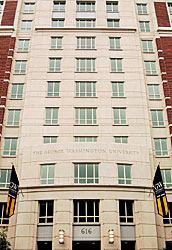 |
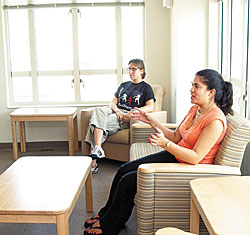 |
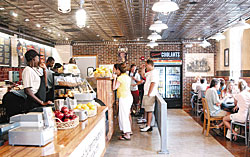 |
GW Honors Top Donors
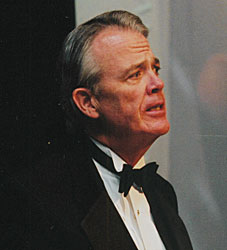
Raymond Oglethorpe, MS ’69, GW trustee and chair of the GW Society, thanks donors for their generous support of the University.
Photo by Dave Scavone
|
Fifty-one new members of The George Washington Society and 37 charter members of the 1821 Benefactors were honored last spring at The George Washington Society Dinner. This group represents the largest group of honorees in the history of The George Washington Society as well as gifts made in excess of $76 million. As President Stephen Joel Trachtenberg remarked that evening, “This is a room chock full of people who responded magnificently to the call to participate in supporting a great University and, as a direct result of your generosity, the goals for the University that always seemed so unattainable now seem within reach.”
The George Washington Society is the University’s highest level of donor recognition. Its members are leaders in philanthropic support, having made a lifetime commitment of $100,000.
The 1821 Benefactors are the University’s most generous donors. Named for the year the University was founded, 1821 Benefactors are individuals who have made the most significant gifts to GW, contributing $1 million or more. Membership in the society is granted by the GW Board of Trustees.
|

Fall at GW’s Mount Vernon Campus
Alumni, families, friends, and neighbors gathered at The George Washington University’s Mount Vernon Campus on Foxhall Road in Washington for the annual Day at The Vern on Oct. 24. The day-long community event offered the public a jazz brunch, a soccer game, film exhibitions, trick-or-treat activities, and a barbecue.
Photo by Benjamin Solomon
|
High-Tech Hideaway
 At GW’s Virginia Campus in Ashburn, a new data center, computer system, churns quietly in the basement of one of the campus’ buildings. Formerly owned by Internet technology services company PSINet, the building was purchased by GW two years ago. The 10,000 square-foot data center is supported by 12 staff members, two dozen server racks, two independent power systems, 130 tons of cooling from redundant air conditioners and top-notch security. Its staff members work 24 hours a day at the new network operations center to monitor systems, security, The Weather Channel, and CNN. With this data center and the one at the Foggy Bottom Campus, the University is able to fully back up key University systems such as those for accounting, e-mail, and student data, should one of the two facilities experience problems due to weather or another emergency. The two campuses are located 32 miles apart. At GW’s Virginia Campus in Ashburn, a new data center, computer system, churns quietly in the basement of one of the campus’ buildings. Formerly owned by Internet technology services company PSINet, the building was purchased by GW two years ago. The 10,000 square-foot data center is supported by 12 staff members, two dozen server racks, two independent power systems, 130 tons of cooling from redundant air conditioners and top-notch security. Its staff members work 24 hours a day at the new network operations center to monitor systems, security, The Weather Channel, and CNN. With this data center and the one at the Foggy Bottom Campus, the University is able to fully back up key University systems such as those for accounting, e-mail, and student data, should one of the two facilities experience problems due to weather or another emergency. The two campuses are located 32 miles apart.
Photo by Claire Duggan
The J Street Scene
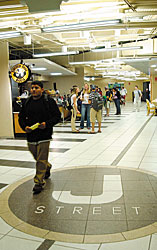 The J Street food court in the Marvin Center maintains its reputation as the student gathering place of choice, thanks to a recent renovation, or rather, reinvention, of J Street, courtesy of Aramark Services and the University. In keeping with the modern theme and political bend of the University, J Street now features more flat-screen televisions throughout the space, which televise live news and events from popular broadcast stations. Aramark and GW celebrated the reopening of J Street this fall with a series of activities and events including a sumo wrestling ring, a “velcro wall,” a “Coke Cash Capture,” a tasting menu, and a “District Market Dash” on Sept. 20. The J Street food court in the Marvin Center maintains its reputation as the student gathering place of choice, thanks to a recent renovation, or rather, reinvention, of J Street, courtesy of Aramark Services and the University. In keeping with the modern theme and political bend of the University, J Street now features more flat-screen televisions throughout the space, which televise live news and events from popular broadcast stations. Aramark and GW celebrated the reopening of J Street this fall with a series of activities and events including a sumo wrestling ring, a “velcro wall,” a “Coke Cash Capture,” a tasting menu, and a “District Market Dash” on Sept. 20.
The grand reopening culminated with the lighting of the “Media Monument,” a new two-story replica of the Washington Monument positioned in the heart of J Street. The renovation is a product of Aramark’s partnership with GW to create a gathering space with dining services reflecting the diversity and culture of the District.
Photo by Claire Duggan
|
Reagan’s GW Legacy
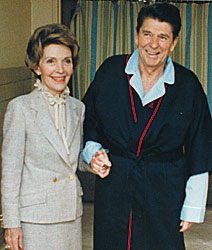 In observance of the national day of mourning declared by President George W. Bush to honor the late President Ronald Reagan, the University closed June 11. “President Reagan was an inspirational leader and a dear friend to The George Washington University,” says GW President Stephen Joel Trachtenberg. In observance of the national day of mourning declared by President George W. Bush to honor the late President Ronald Reagan, the University closed June 11. “President Reagan was an inspirational leader and a dear friend to The George Washington University,” says GW President Stephen Joel Trachtenberg.
The Reagan family’s ties to GW, while forged in tragedy, left a lasting impact on the University community.
On March 30, 1981, after being shot during the assassination attempt outside the Washington Hilton Hotel, the president, Press Secretary James Brady, and Secret Service agent Timothy McCarthy received immediate, life-saving treatment at GW Hospital from a group of more than 60 doctors and nurses.
Students and faculty and staff members cheered the Reagan, Brady, and McCarthy families with an outpouring of support. The president and first lady smiled as they read banners hung from the sides of buildings, visible from his hospital room. Cards and flowers from the GW community mixed with those from around the globe as the president made a full recovery.
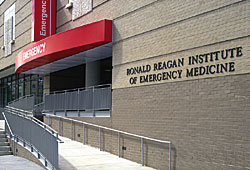 The president returned to GW 10 years after his admission to the hospital to receive an honorary Doctor of Public Service degree. The University placed a plaque inside the hospital’s emergency room to honor Nancy Reagan’s courage and determination during a time that shook the world. And the University dedicated the Ronald Reagan Institute of Emergency Medicine at the GW Medical Center to consolidate and expand upon existing research and education in emergency medicine. The president returned to GW 10 years after his admission to the hospital to receive an honorary Doctor of Public Service degree. The University placed a plaque inside the hospital’s emergency room to honor Nancy Reagan’s courage and determination during a time that shook the world. And the University dedicated the Ronald Reagan Institute of Emergency Medicine at the GW Medical Center to consolidate and expand upon existing research and education in emergency medicine.
Today, the Reagan Institute continues to provide research, education, and training to strengthen the health and welfare of the GW, national, and international communities.
—LE
GW Welcomes Five New Trustees
Chairman Charles T. Manatt Elected to Three-Year Term
GW's Board of Trustees elected its executive committee and five new trustees during its summer meeting. Charles T. Manatt, JD ’62, was elected to a three-year term as chairman of the board, a position he has held since 2001.
The newly elected charter trustees are: Richard Blackburn, JD ’67, who is retired from Duke Energy Corporation, where he served most recently as executive vice president and general counsel; Maria Bonetti, vice president of Centro de Integacion Familiar of New York and Santo Domingo, Dominican Republic; and Mark Shenkman, president, chief investment officer, and founder of Shenkman Capital Management in New York. The newly elected alumni trustees are: Allan From, BBA ’72, JD ’75, a partner with Howard, Stallings, From & Huston in Raleigh, N.C.; and Kristy McDonnell, BS ’00, MS ’01, an energy engineer for Pace Global Energy Services.
|
The Mysteries of Megiddo
Students participate in excavation at historic Israeli site
|
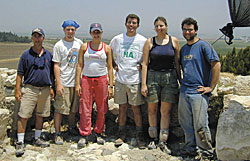 (Left to right) Associate Professor Eric Cline with students Max Wolk, Sarah Loyer, Jonathan Greenberg, Courtney Prutzman, and Michael Saltzman. (Left to right) Associate Professor Eric Cline with students Max Wolk, Sarah Loyer, Jonathan Greenberg, Courtney Prutzman, and Michael Saltzman.
|
For more than 100 years, archaeologists and scholars have been excavating at Megiddo, a site in Israel perhaps better known as biblical Armageddon. In June, five GW students joined Associate Professor of Classics Eric Cline at the site to help answer questions left by previous expeditions, search for new artifacts and structures, and unravel the mysteries of Megiddo.
Since 1994, Tel Aviv University has partnered with other institutions of higher learning such as GW and Penn State to organize the excavations. Because of unrest in the region this year—and the U.S. government’s warnings to travelers and students in the area—Cline and his students were not officially sanctioned by the University but instead enrolled in the Tel Aviv program and joined together at Megiddo. Working with students and instructors from other universities and with professionals from around the world, the GW group split up and worked in different areas on the site, including stables, tombs, and residences.
“We got a lot done and covered a lot of ground,” Cline says. “It was fascinating work—20 cities built on top of one another over the ages. We were trying to answer questions about parts of the mound that cover hundreds of years.
“For example, the area in which I work has one building which has been identified as ‘Solomon’s stables’ and another building in the city directly underneath it which has been identified as ‘Solomon’s palace.’ Which is it? They can’t both have been built by Solomon if they are from different cities, one on top of the other. We were seeking to correctly identify the dates of the various cities, who was in charge, and what life was like back then. The students had a wonderful time and were able to uncover some interesting artifacts and contribute significantly to the efforts.”
Stepping into Cline’s office, it’s easy to see why students are willing to sacrifice three weeks of their summer vacation to work with him. History blends with humor as small busts of ancient rulers are lined up next to a cheap plastic Moses complete with “stone” tablets. A large poster of Indiana Jones, whip sailing in the air, hangs behind his desk. The newly appointed chair of the Classical and Semitic Languages and Literatures department seems to celebrate the mystery and romance of archaeology as much as the historical and intellectual weight of the discipline.
|
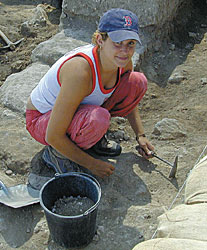
Student Sarah Loyer excavates at Megiddo.
|
“The decision to go to Megiddo was a mixture of the influence of Professor Cline and my family. Professor Cline encourages everyone who takes his archaeology class to go on a dig, and I have an uncle who has been to Megiddo and thought it was amazing,” says sophomore Michael Saltzman, who worked in an area just east of a tomb site. “The tomb was completely empty when found in the early 1900s, probably robbed in antiquity. Our mission was to shed some light on what time period the tomb came from and, if possible, for whom it was made.”
Saltzman, who cites waking up at 4:30 a.m. and the hard physical labor of working with pick-axes and shovels as the biggest challenges of the excavation, says he gained learning experiences at the site that went beyond archaeology.
“Getting to know people from around the world and knowing that our work might shed some light on questions being asked for years—or which could just create more questions—was amazing,” he says. “Everyone enjoys what they are doing there. I left with the knowledge that anything else I could do during the summer probably wouldn’t be as fun.”
Senior Courtney Prutzman, whose first excavations were digging for bones and artifacts in her mother’s garden as a child, is a biological anthropology major who also interns at the Smithsonian National Museum of Natural History and is senior secretary in the Department of History. Her lifelong interest in the Near East—and the desire to go on a dig sparked by Cline—led her to Megiddo.
She worked in the domestic part of the site, and says she was excited with her group’s discoveries.
“We found several cooking installations, animal bones, and pottery, and got a feel for what it was like to live and work in an Iron I/Late Bronze Age household. The most rewarding aspect of the dig was the discovery of a burial. The individual we found was about two to three years old and was buried with a flask and a shell bead. We named him ‘Evan,’ which means ‘the rock’ in Hebrew,” she says. “Megiddo helped to reinforce that archaeology is, indeed, what I want to do with my life.”
Cline and his team say they took away a deeper understanding of one of the world’s most famous excavation sites as well as memories that will last a lifetime. Of course, they also went away with bragging rights. Cline and the students each have a T-shirt that proudly proclaims, “I survived Armageddon.”
—LE
|